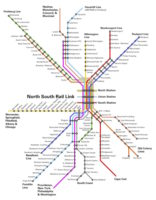
The northeast corner of North Korea, adjacent to China and Russia, is showing incipient signs of development. The Rason Special Economic Zone, where foreign investment is permitted, includes an ice-free port and offers potential as a trans-shipment point.
China needs greater access to the sea to assist in moving cargo out of its landlocked northeast provinces. China leases one pier at Rason’s port to ship coal to southeast China and has offered to lease two additional piers. But Rason’s electricity grid is antiquated, causing frequent blackouts. While China is considering investing in upgrading Rason’s grid, progress is glacial, due to North Korea’s murky decision-making process.
One of Rason’s bright spots is the reconstruction of a rail link from Russia by RasonKonTrans, a joint venture 70% owned by RZD (Russian Railways) and 30% owned by North Korea. “RZD is completing the reconstruction of the segment from Khasan, Russia, to Rajin, North Korea, as well as the construction of a trans-shipment terminal in the port of Rajin,” according to Aiste Marija Bloznelyte, a representative of Mikhailov & Partners, a media representative for RZD.
The project entails reconnecting the dual-track railway, with both 1,520-millimeter and 1,435-mm gauges, on the stretch from Khasan, on the Russian side, to the North Korean port of Rajin, a distance of 54 kilometers. While North Korea uses standard 1,435-mm gauges, RZD uses 1,520-mm gauges. The segment includes three tunnels—measuring 3.8 km, 499 meters and 301 m in length, respectively—and a wooden bridge across the Tumen River. Construction was carried out by the Far East Mining Construction Co., RZD’s primary construction arm, and RZDstroy. “The line will be opened for freight traffic at the end of August,” according to Bloznelyte.
The final part of the project is the development of a container terminal at the port of Rajin that will handle the bulk shipment of coal. The terminal is slated for completion in the fourth quarter of 2013, according to RZD. “Cargo volumes could rise to over four million tonnes per year in bulk cargo, or up to 100,000 containers per year.”
This project, while limited in scope, holds tremendous potential as a pilot project for the eventual reconstruction of the railway across all of North Korea, reconnecting with South Korea’s rail system. Such a trans-Korea railway would offer a faster and cheaper way for South Korea to send exports to China and Europe that now have to be shipped by sea.



Post a comment to this article
Report Abusive Comment